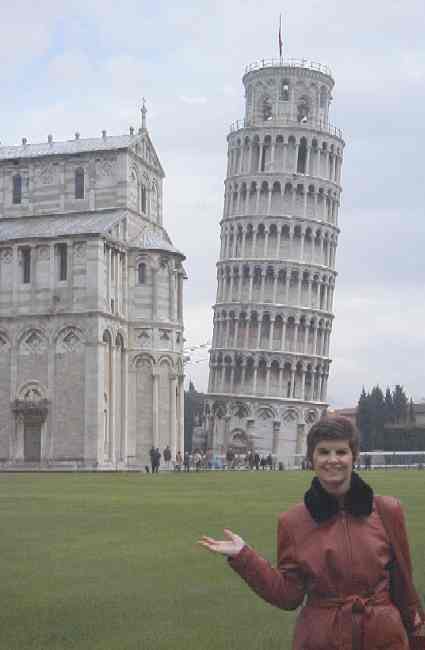

We woke to the thumping of the Italian Riveria surf, had a quick breakfast at the top of the nearly empty hotel, and were shortly on our way to Pisa, about a 1/2 hour down the super highway. The irony is that Pisa itself was founded on the Tyrrhenian sea, but the Arno kept dishing the dirt in front of it, moving it upstream about 6 miles by extending the river. It remained a harbor (including a Roman naval base) for a long time and was a major player in world trade where it influenced and fell under the influence of all the major players in the Mediterranean Basin.
Just to prove we will not stoop that low for a laugh, we did NOT have Pietrina holding back the tower like every other tourist photo ever made in the Piazza del Duomo (more often called Campo dei Miracli) -- a spacious plaza which the Pisans reengineered in the 1800s by clearing out a lot of undesirable buildings. The results are magnificent. Pisa's three jewels of Romanesque/Gothic architecture and one also-ran stand (even if somewhat on a slant) in decorated majesty in a park-like setting -- unlike their sister Cathedral squares in Siena's crowded streets or Florence's swirling traffic.
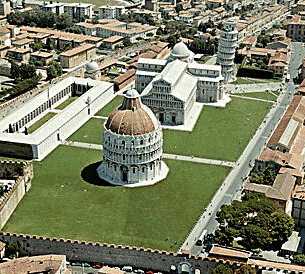
Such tourist urban renewal was somewhat easier for the Pisans than in most Tuscan towns as the Cathedral buildings had originally been built outside of the early city, away from the river where it was less likely to flood. The soil which the river deposited eons before, however, proved to be just as soft as anywhere else in Pisa, causing the poor building posture.
Approaching Pisa, we found many parking lots closed for the season but eventually got within walking distance of the well maintained city walls (which gird much of the medieval city in approximately a 10K circuit). Soon we were walking down the Piazza dei Miracli (the Square of Miracles). Perhaps called a miracle because somehow the Leaning Tower doesn't completely tip over. But more on that later. Anyway, here's what we saw upon entering the walls:
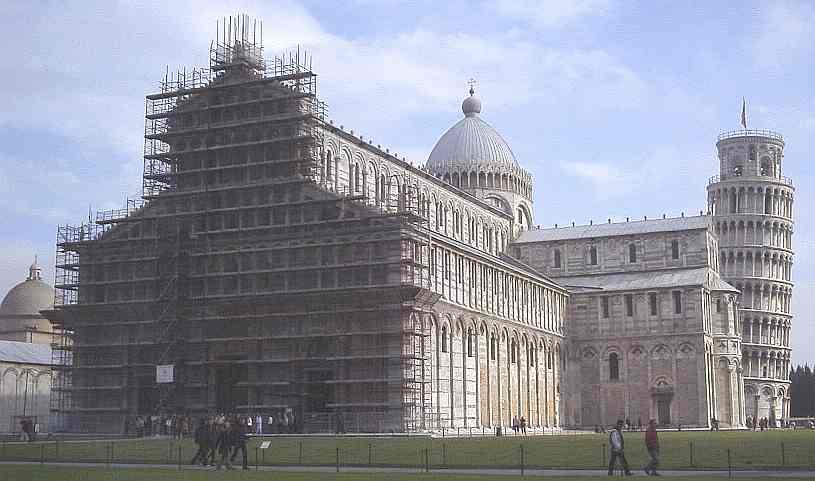
Pretty impressive, despite the scaffolding obliterating the Cathedral facade. Our first stop was to the Duomo built on the site of the Roman Emperor Hadrian's Palatium. Using the spoils of their battles with the Saracens, the Pisans funded and built their Cathedral from 1063 through 1120 with touches added during a 17th century restoration after a fire. The building helped to define Pisan Gothic.
If you want to see the square in all 360 degrees, try the Nova site.Unlike most cathedrals we've visited, we had to enter through the back (apse) door and wind our way through to the front façade -- probably the reverse of the impact the architects (Buscheto and Rainaldo) intended. Our first visit was cut short after a few pictures before Sunday Mass started. (tripods, mass, it's always something. They act like this is a church, for God's sake!). Anyway, we came back later and took these shots. Here's the full nave, taken from the back:
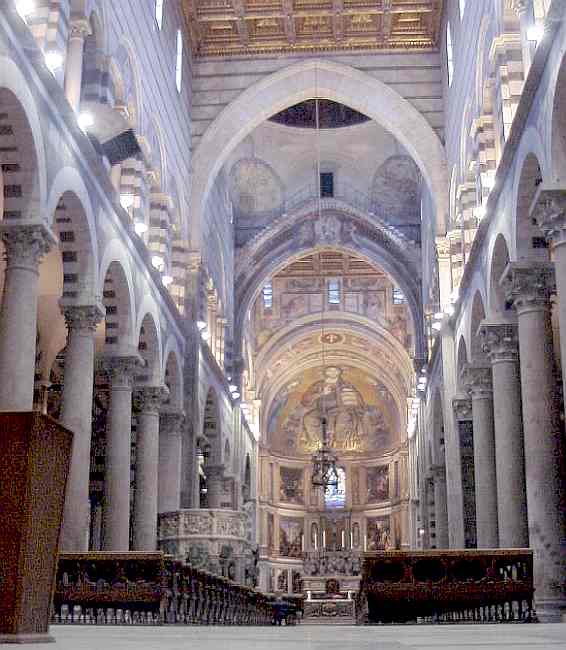
The upper galleries were reserved for women. The bit of recessed ceiling you see is Florentine. The columns support multi-colored marble arches as in Siena but without the strong horizontal orientation. On the left you see another marble pulpit we'll visit in a moment. The hanging lantern supposedly inspired Galileo to hypothesize how a pendulum could improve the innards of watches, the first time in the history of science that thought preceded experiment. More likely, he was inspired by some other swinging lantern as the one in the picture was installed four years after his discovery. (Into this stuff? If so, check this site at http://www.uh.edu/engines/epi1307.htm by my favorite science historian, John H. Lienhard.)
As you see over the apse in the distance a large mosaic of Christ similar to the Pantocrator images in the Norman churches in Sicily. Here's a close-up of the gold mosaic of the Christ between Mary and John the Baptist:
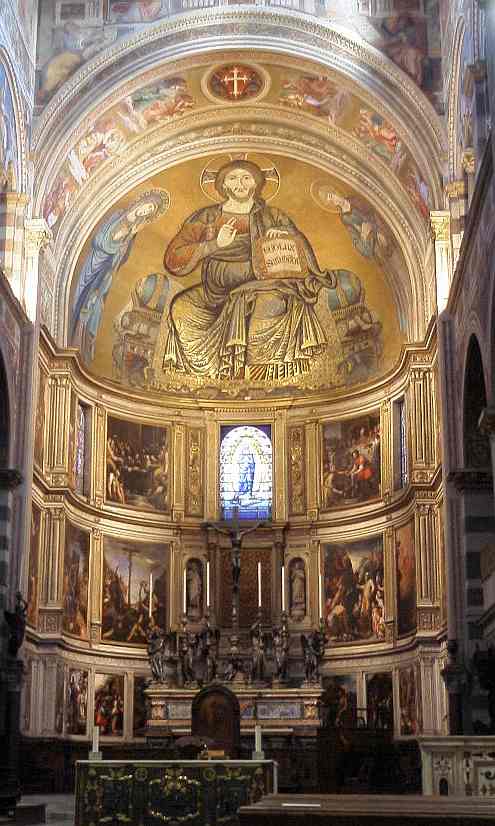
Did Pisa beat out Siena for best pulpit? This one is the masterpiece of the same Italian Gothic sculptor family, Nicola and his son Giovanni Pisano who took 10 years to finish it. Unlike earlier versions in Siena (7 finished sides) and the Pisa Baptistery we'll see below (a hexagon), this one has 8 curved sides giving it the impression of being a circle. Pisano was an early adherent of the Texas "too much ain't enough" policy and crammed the upper panels with New Testament scenes and numerous people much like sardines in a can. (You may think I'm trashing this pulpit but the Pisans were worse and knocked this pulpit down in 1602 only to restore it in 1929 in a different spot. They couldn't find all the pieces and the stairs today are obviously makeshift).
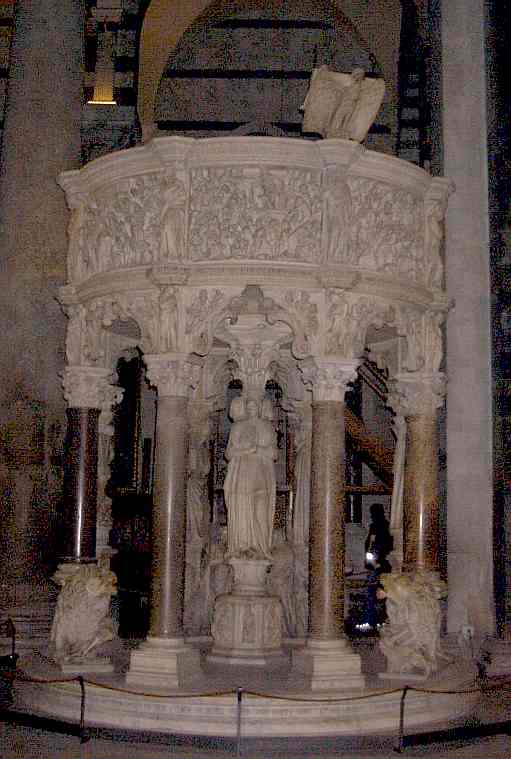
My photo does not do justice to this carving (but at least isn't bad as my writing). If you want to see the panels in detail (plus some other pulpits by Giovanni Pisano), try this link:
The church is filled with other significant art from several eras, in part because a 1595 fire gave the Pisans a chance to restock the inside during the high renaissance. Mostly they chose their artists well. However, with typical Italian flourish, the right transept chapel contains the remains of Pisa's patron Saint Ranieri displayed macabrely behind glass framed in dark marble.
Unfortunately scaffolding covered the west Cathedral façade and so we missed the inlaid marble and all the other exquisite trappings. Walking westward across the yard, we next stopped at the Baptistery; here's a shot of its outside bristling with scaffolds over its Pisa Romanesque-arched lower two levels topped by Gothic loggia (gallery) added a century later. (You can vary the styles when you take centuries to complete a structure. This one started around 1150).
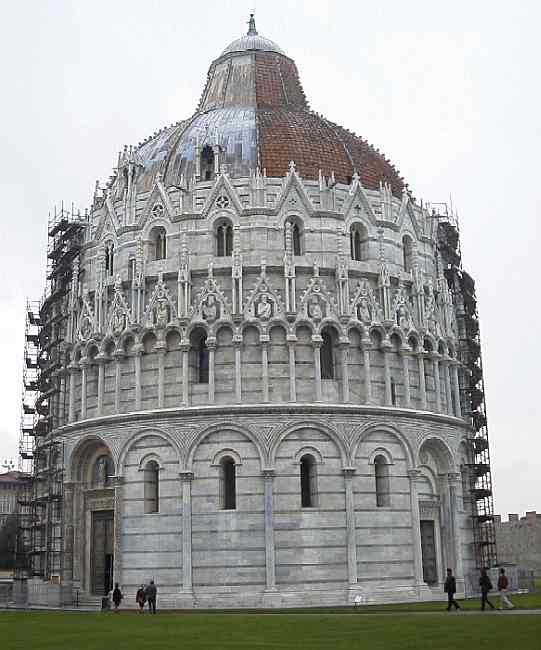
And a close-up: What you're seeing is a copy of Giovanni Pisano's Virgin and Child. (Most of the original statues have been moved inside the Cathedral Museum at the other end of the square.) From the grass roots level where we stood, you can't tell the difference. Ditto for the row of the usual suspects below the statue lined up on the lintel. Shows what you can do if you take your time. In the case of this building, the Pisans took 250 years to finish. (You thought the contractor who did your kitchen was slow! -- maybe you were married to him at the time. Don't fret. The Italians still don't seem to be in much of a hurry except when driving).
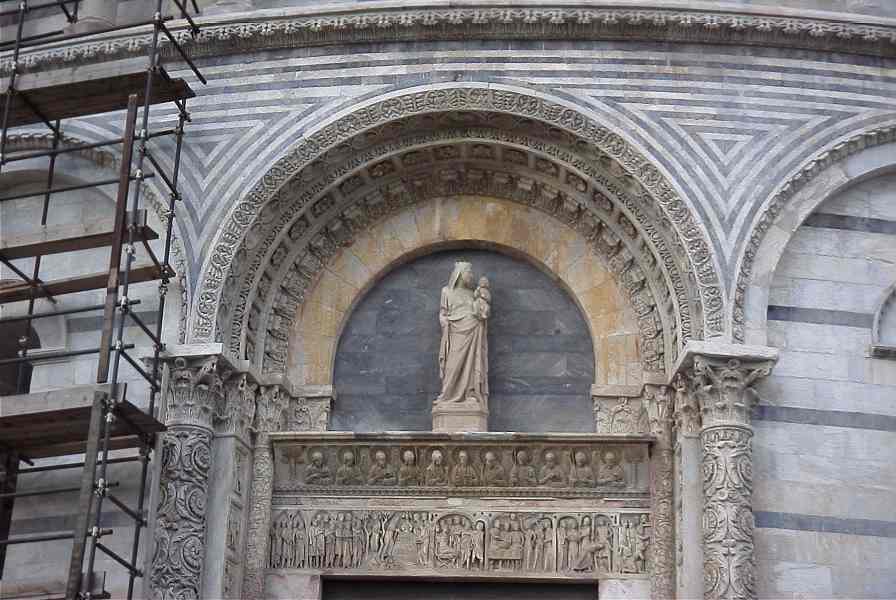
This is another leaning tower of Pisa as it is not only the largest baptistery in Italy but is also slightly taller (if you count the bronze statue of John the Baptist on the top) than its more famous sibling which sits like a Texas wedding cake on the other side of the cathedral. And yes, the Baptistery leans too, as do most tall medieval buildings in Pisa as the alluvial soil and high water table do not allow much foundation for weighty marble structures.
Inside the Baptistery is large but simple. The acoustics are remarkable as was demonstrated by one of the guards who hummed a note that echoed forever and seemed to grow fat with overtones as it lingered. Stairs lead to the intermediate level gallery with this view of the interior. (Ignore the tan lines, it's just my inept photo editing trying to smooth the uneven lighting. Blame me, not the architect, as the design lets in much sunlight for a Romanesque building.)
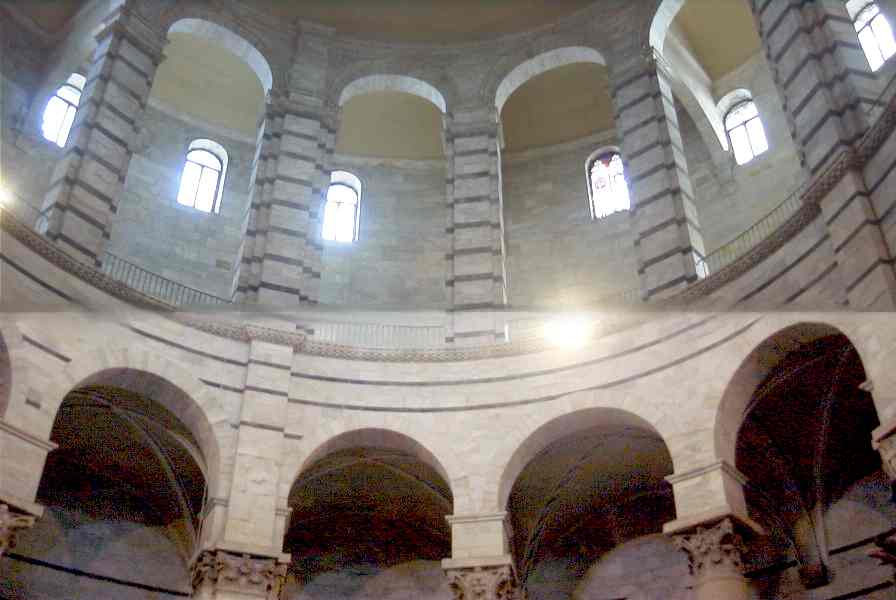
From this upper level, further stairs lead to the outside viewing area near the top of the structure. Returning downstairs, we see the Baptistery's contribution to the pulpit wars, again by the same Pisano family, this one by the founder, Nicola, around 1260. Nicola's son and many fellow sculptors contributed to the New Testament scenes. The Eagle is the symbol of the Republic of Pisa. This was the first of the great pulpits. The Pisanos would later build the one we saw in the Siena cathedral and finally culminate with the one in the Pisa Duomo we mentioned earlier on this very long page.
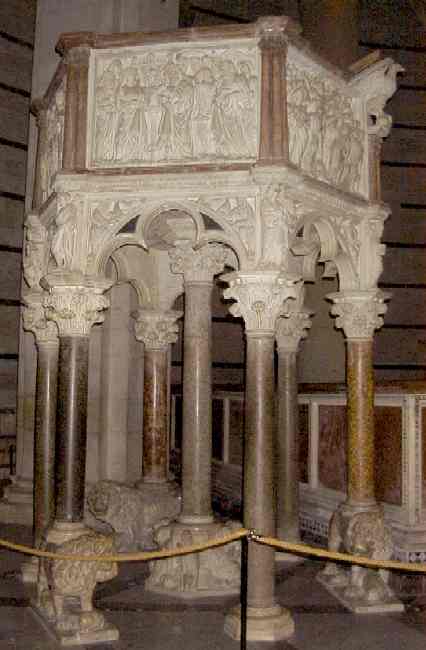
As you might expect, the Baptistery has a font. A good one designed in 1245 by Guido Bigarelli. Eight sided (as Christian numerology holds 8 to be the number of beginnings.) Each of the 8 sides has two carved marble panels. Together they enclose a space large enough for total immersion (which is the way they baptized then except for newborns) and a much newer statue of John the Baptist.
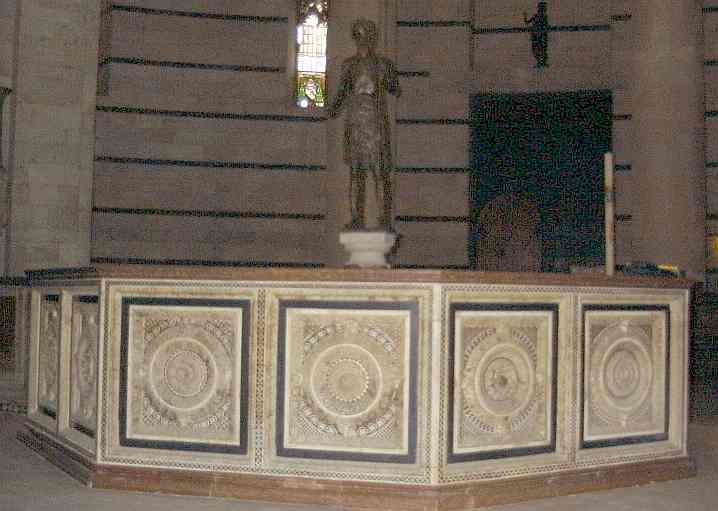
Next we walked to the other end of the Cathedral square to visit Pisa's most famous mistake, the leaning tower. Please join us by clicking here.
Curious as to why these medieval churches so often have lavish (usually eight-sided) baptisteries? All is answered at this site.
Where do you want to go today? Here's a few choices:
